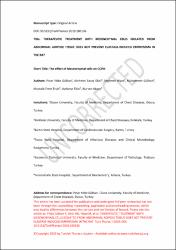| dc.contributor.author | Gülhan, Pınar Yıldız | |
| dc.contributor.author | Ekici, Mehmet Savaş | |
| dc.contributor.author | Ekici, Aydanur | |
| dc.contributor.author | Niyaz, Mehmet | |
| dc.contributor.author | Gülhan, Muhammet | |
| dc.contributor.author | Ercin, Mustafa Emre | |
| dc.contributor.author | Aksoy, Nurkan | |
| dc.date.accessioned | 2021-01-14T18:22:00Z | |
| dc.date.available | 2021-01-14T18:22:00Z | |
| dc.date.issued | 2020 | |
| dc.identifier.citation | Gülhan PY, Ekici MS, Niyaz M, Gülhan M, Erçin ME, Ekici A, Aksoy N. Therapeutic Treatment with Abdominal Adipose Mesenchymal Cells Does Not Prevent Elastase-Induced Emphysema in Rats. Turk Thorac J. 2020 Jan;21(1):14-20. | en_US |
| dc.identifier.issn | 2149-2530 | |
| dc.identifier.uri | https://doi.org/10.5152/TurkThoracJ.2019.180136 | |
| dc.identifier.uri | https://app.trdizin.gov.tr/makale/TXpnME56a3pNdz09 | |
| dc.identifier.uri | https://hdl.handle.net/20.500.12587/13976 | |
| dc.description.abstract | OBJECTIVES: Emphysema and chronic bronchitis have different pathophysiologies but both are significant components of chronic obstructive lung disease (COPD). The levels of Matrix metalloproteinase (MMP)-9 in the bronchoalveloar lavage fluid (BALF) and in serum indicate the presence of emphysema. Intratracheal administration of elastase has been used to create a rat model of emphysema. Adipose tissue-derived mesenchymal stem cells (MSC) have been postulated to prevent or reverse emphysema, however, this has not been examined in the rat model of elastase-induced emphysema. MATERIALS AND METHODS: In this study, 31 Wistar albino rats aged 6–8 weeks and weighing 250–300 g were assessed. On day 1, the animals were treated intratracheally with 0.5 mL saline (control group, n=10), i.e., 0.5 mL saline solution containing 0.1 IU porcine pancreatic elastase (PPE) (Elastase group, n=12) or PPE plus MSC (Elastase-MSC group, n=9) was adminstered per animal. MSCs suspended in serum were injected via the caudal vein on day 21. At least 106 cells were injected. All animals were sacrificed on day 42 and the emphysema index (EI) was calculated, along with measuring the BALF and serum MMP-9 concentrations. RESULTS: Porcine pancreatic elastase induced a significant degree of emphysema in the PPE groups as compared to the control group, which was determined by the EI index (p=0.008). This was not reversed by MSC treatment. The EI remained significantly low in comprison with the controls (p=0.001) and measured no different from the Elastase-treated animals. There was no statistically significant difference between the BALF and serum MMP-9 levels between the control and treatment groups. CONCLUSION: Our findings suggest that therapeutic treatment with adipose tissue-derived MSC in rats has no effect on emphysema or on MMP9 expression, which is a known marker of emphysema. | en_US |
| dc.language.iso | eng | en_US |
| dc.relation.isversionof | 10.5152/TurkThoracJ.2019.180136 | en_US |
| dc.rights | info:eu-repo/semantics/openAccess | en_US |
| dc.title | Therapeutic Treatment with Abdominal Adipose Mesenchymal Cells Does Not Prevent Elastase-Induced Emphysema in Rats | en_US |
| dc.type | article | en_US |
| dc.identifier.volume | 21 | en_US |
| dc.identifier.issue | 1 | en_US |
| dc.identifier.startpage | 14 | en_US |
| dc.identifier.endpage | 20 | en_US |
| dc.relation.journal | Turkish Thoracic Journal | en_US |
| dc.relation.publicationcategory | Makale - Ulusal Hakemli Dergi - Kurum Öğretim Elemanı | en_US |
















